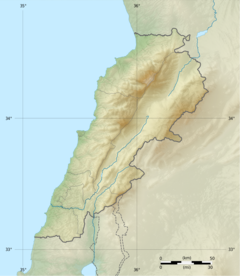Ras El Kelb
| Location | 8 km (5 mi) from Beirut, Lebanon |
|---|---|
| Coordinates | 33°55′7″N 35°35′9.9″E / 33.91861°N 35.586083°E |
| Part of | Settlement |
| History | |
| Material | Limestone |
| Founded | c. 50,000 BC |
| Periods | Paleolithic |
| Cultures | Mousterian |
| Site notes | |
| Excavation dates | 1959 |
| Archaeologists | Dorothy Garrod, G Henri-Martin, |
| Public access | Yes |
Ras El Kelb is a truncated seaside cave and Paleolithic settlement located on the low-lying (5 m (16 ft)) coast of Lebanon, 8 km (5.0 mi) north of Beirut. It is one of the oldest habitations found in the country.[1]
Rescue excavations were carried out in 1959 by Dorothy Garrod and G. Henri-Martin.[2] They dug 2 trenches named the 'Rail' and 'Tunnel' trenches, from which they recovered over 30,000 flint artefacts of a wide variety for statistical analysis from 22 geological layers.[3] It was concluded that the sea had passed the level of the cave 3 times since its first dated habitation around 50,000 years BCE (52,000 years BP).[4]
They also discovered a tooth suggested to belong to a Neanderthal. It was suggested that the inhabitants were expert at hunting gazelle using the flints recovered.[5]
References
- ^ Copeland, Lorraine and Moloney, Norah (eds) (1998) The Mousterian Site of Ras el-Kelb, Lebanon BAR IS 706. ISBN 0-86054-939-9
- ^ Garrod, D. and Henri-Martin, G., Fouilles a Ras el-Kelb, Liban, 1959. Actes du 16eme Congres Prehistorique de France, Monaco, 1959.
- ^ Garrod, D. and Henri-Martin, G., Rapport Preliminaire sur la fouille d'une grotte a Ras el Kelb, Liban, 1959, Bulletin du Musee de Beyrouth, XVI : 61-7, 1961.
- ^ Garrod, D., The Middle Paleolithic of the near East and the Problems of Mount-Carmel Man., Journal of the Royal Anthropological Society, 92 : 232-51, 1962.
- ^ Copeland, Lorraine., The Middle Paleolithic of Adlun and Ras El Kelb (Lebanon): First results from a study of the flint industries, pp. 33-57, Paléorient, Volume 4, Number 4, 1978.
